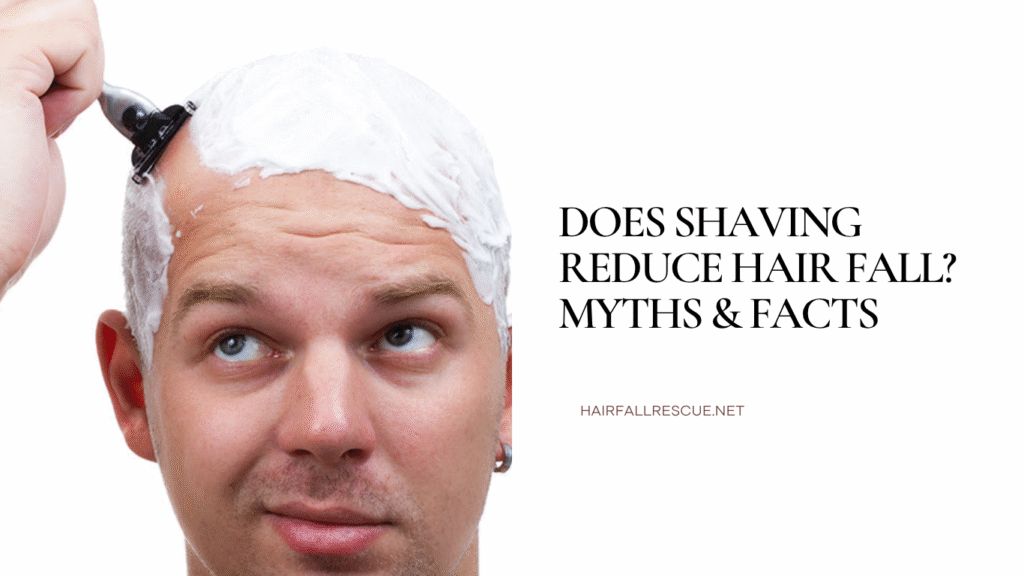Does Shaving Your Head Reduce Hair Fall? The Truth Revealed
Introduction
Hair fall is a common concern affecting millions worldwide, leading many to seek quick fixes—including shaving their heads. But does shaving really reduce hair fall, or is it just a myth?
In this comprehensive guide, we’ll explore:
- The science behind hair growth and hair fall
- Whether shaving affects hair thickness and density
- Common myths vs. facts
- Alternative solutions for hair fall
Want personalized hair loss advice? Book a free consultation with our hair specialists and get a customized treatment plan.
How Hair Growth Works
Before understanding if shaving helps, it’s essential to know how hair grows. Hair growth occurs in three phases:
- Anagen (Growth Phase): Lasts 2-7 years—hair actively grows.
- Catagen (Transition Phase): Lasts 2-3 weeks—hair stops growing.
- Telogen (Resting Phase): Lasts 3 months—hair falls out, and new hair replaces it.
Shaving only cuts hair at the surface—it doesn’t affect follicles or growth cycles. For more detailed information on hair biology, check this NIH research paper on hair growth.
Does Shaving Reduce Hair Fall?
Myth: Shaving Makes Hair Thicker
Many believe shaving leads to thicker, stronger hair. However, this is a misconception. When hair regrows after shaving, it has a blunt tip, making it feel coarser—but the thickness remains unchanged.
Fact: Shaving Doesn’t Affect Hair Fall
Since shaving only trims the visible part of the hair (the shaft), it doesn’t impact hair follicles or reduce shedding. Hair fall is primarily influenced by genetics, hormones, diet, and scalp health.
Temporary Solution, Not a Cure
Shaving may give the illusion of less hair fall since shorter hairs are less noticeable when shedding. However, it doesn’t address the root cause of hair loss.
Struggling with excessive hair fall? Take our 2-minute hair loss quiz to identify potential causes and solutions.
Common Causes of Hair Fall
Understanding why hair falls is crucial. Major causes include:
- Genetics (Androgenetic Alopecia): Hereditary hair loss affects both men and women.
- Hormonal Imbalances: Thyroid issues, pregnancy, or menopause can trigger shedding.
- Nutritional Deficiencies: Lack of iron, protein, or vitamins weakens hair.
- Stress & Lifestyle: Poor sleep, stress, and pollution contribute to hair thinning.
- Scalp Conditions: Dandruff, fungal infections, or psoriasis disrupt hair growth.
The American Academy of Dermatology provides excellent resources on different types of hair loss and their causes.
Expert-Backed Ways to Reduce Hair Fall
Instead of shaving, consider these proven methods:
1. Balanced Diet for Hair Growth
- Eat protein-rich foods (eggs, lentils, fish).
- Include iron (spinach, red meat) and biotin (nuts, seeds).
2. Scalp Care & Treatments
- Use minoxidil (FDA-approved for hair regrowth).
- Try PRP therapy (stimulates follicles).
3. Reduce Stress & Improve Sleep
- Practice meditation or yoga.
- Get 7-8 hours of sleep.
4. Avoid Harsh Hair Practices
- Limit heat styling and tight hairstyles.
- Use sulfate-free shampoos.
Ready to combat hair loss? Browse our clinically-proven hair growth products recommended by dermatologists.
FAQs
1. Will my hair grow back thicker after shaving?
No, shaving doesn’t change hair thickness—only the blunt tip makes it feel coarser.
2. Can shaving prevent baldness?
No, baldness is genetic. Shaving doesn’t affect follicle health. Learn more about hair loss causes at Mayo Clinic.
3. How often should I shave to reduce hair fall?
Shaving frequency doesn’t impact shedding since it doesn’t stop hair fall.
Conclusion
Shaving your head may give a temporary illusion of reduced hair fall, but it’s not a solution. For lasting results, focus on scalp health, diet, and medical treatments.
If you’re considering shaving, do it for confidence—not as a hair loss fix!
Want more hair care tips? Subscribe to our newsletter and get weekly expert advice delivered to your inbox.



